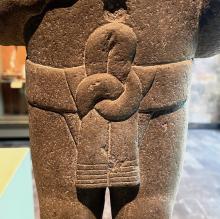maxtlatl (Mdz43r)
This is an example of supportive iconography, not a glyph per se as it was used on the given page. This loincloth (maxtlatl)] has a bound loop at the top, with two hanging strips of cloth or leather. The cloth or leather is dyed red. At the bottom of the strips, however, is a portion that is white, with some geometrical patterns that are called grecas in Spanish and, below them, what might be fringe. Loincloths were worn by men, in front of their genitals. A waist belt held them on.
Stephanie Wood
We cannot see the strap that would have tied this loincloth around the waist. This image, an example of iconography found in the tributes section of in the Codex Mendoza, is provided as support for the reading of maxtlatl in the glyph for the place name, Amaxtlan, which is simply white with some horizontal black lines. This more colorful example is associated with a place called Maxtlac, as indicated by the gloss that appears on the same folio (43 recto). The loincloth in the compound glyph for Amaxtlan is white with black horizontal lines forming the design at the bottom of the cloth strips. This iconographic example has no designs at the bottom, but it involves combined strips of cloth in multiple colors--yellow, turquoise, red and green, going from left to right. Loincloths were worn by men, in front of their genitals. A waist belt held them on. Differences in designs of maxtlatl probably related to social status (loincloths for the lower social strata were made from maguey fiber according to Henry B. Nicholson and Eloise Quiñones Keber in the Art of Aztec Mexico, 1983, p. 183), and perhaps also ethnicity and/or occupation. On some occasions, symbolic loincloths were carried in religious processions, such as those described by Kay Read, Time and Sacrifice in the Aztec Cosmos, 1998, p. 81, and Eloise Quiñones Keber in Representing Aztec Ritual, 2002, p. 124.
Stephanie Wood
maxtlac
Maxtlac
Stephanie Wood
c. 1541, but by 1553 at the latest
Stephanie Wood
breechclout, loincloth, clothing, taparrabos, bragas, textiles, maxtlatl
maxtlatl. Detail on a portastandarte, a male figure that would have held a banner on a pole in one of its hands. Note the large knot and the horizontal lines of decoration at the bottom of the loincloth. Museo Nacional de Antropología e Historia, Salón Mexica. Photograph by Stephanie Wood, 14 February 2023.
maxtla(tl), loincloth, https://nahuatl.wired-humanities.org/content/maxtlatl
el taparrabos, la braga, el pareo
Stephanie Wood
Codex Mendoza, folio 43 recto, https://digital.bodleian.ox.ac.uk/objects/2fea788e-2aa2-4f08-b6d9-648c00..., image 96 of 188.
The Bodleian Libraries, University of Oxford, hold the original manuscript, the MS. Arch. Selden. A. 1. This image is published here under the UK Creative Commons, “Attribution-NonCommercial-ShareAlike 3.0 License” (CC-BY-NC-SA 3.0).





